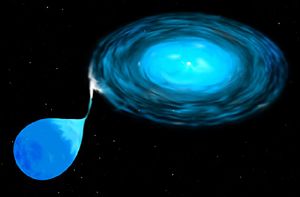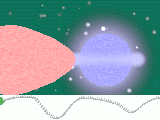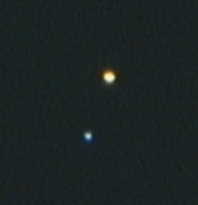Binary star
A binary star is a star system consisting of two stars orbiting around their center of mass. For each star, the other is its companion star. Recent research suggests that a large percentage of stars are part of systems with at least two stars. Binary star systems are very important in astrophysics, because observing their mutual orbits allows their mass to be determined. The masses of many single stars can then be determined by extrapolations made from the observation of binaries.
Binary stars are not the same as optical double stars, which appear to be close together as seen from Earth, but are not bound by gravity. Binary stars can either be distinguished optically (visual binaries) or by indirect techniques, such as spectroscopy. If binaries happen to orbit in a plane containing our line of sight, they will eclipse each other; these are called eclipsing binaries.
Systems consisting of more than two components, known as multiple stars, are also not uncommon. The components of binary star systems can exchange mass, bringing their evolution to stages that single stars cannot attain. Examples of binaries are Algol (an eclipsing binary), Sirius, and Cygnus X-1 (of which one member is probably a black hole).
Contents |
Discovery
The term binary was first used in this context by Sir William Herschel in 1802,[1] when he wrote:[2]
- "If, on the contrary, two stars should really be situated very near each other, and at the same time so far insulated as not to be materially affected by the attractions of neighbouring stars, they will then compose a separate system, and remain united by the bond of their own mutual gravitation towards each other. This should be called a real double star; and any two stars that are thus mutually connected, form the binary sidereal system which we are now to consider."
By the modern definition, the term binary star is generally restricted to pairs of stars which revolve around a common centre of mass. Binary stars which can be resolved with a telescope or interferometric methods are known as visual binaries.[3][4][5] Most of the known visual binary stars have not completed one whole revolution, but are observed to have travelled along a curved path or a partial arc.[6]

The more general term double star is used for pairs of stars which are seen to be close together in the sky.[1] This distinction is rarely made in languages other than English.[3] Double stars may be binary systems or may be merely two stars that happen to be close together in the sky but have vastly different true distances from the Sun. The latter are termed optical doubles or optical pairs.[7]
Since the invention of the telescope, many pairs of double stars have been found. Early examples include Mizar and Acrux. Mizar, in the Big Dipper (Ursa Major), was observed to be double by Giovanni Battista Riccioli in 1650[8][9] (and probably earlier by Benedetto Castelli and Galileo).[10] The bright southern star Acrux, in the Southern Cross, was discovered to be double by Father Fontenay in 1685.[8]
John Michell was the first to suggest that double stars might be physically attached to each other when he argued in 1767 that the probability that a double star was due to a chance alignment was small.[11][12] William Herschel began observing double stars in 1779 and soon thereafter published catalogs of about 700 double stars.[13] By 1803, he had observed changes in the relative positions in a number of double stars over the course of 25 years, and concluded that they must be binary systems;[14] the first orbit of a binary star, however, was not computed until 1827, when Félix Savary computed the orbit of Xi Ursae Majoris.[15] Since this time, many more double stars have been catalogued and measured. The Washington Double Star Catalog, a database of visual double stars compiled by the United States Naval Observatory, contains over 100,000 pairs of double stars,[16] including optical doubles as well as binary stars. Orbits are known for only a few thousand of these double stars.[17]
Classifications
By methods of observation
Binary stars are classified into four types according to the way in which they are observed: visually, by observation; spectroscopically, by periodic changes in spectral lines; photometrically, by changes in brightness caused by an eclipse; or astrometrically, by measuring a deviation in a star's position caused by an unseen companion.[3][18] Any binary star can belong to several of these classes; for example, several spectroscopic binaries are also eclipsing binaries.
Visual binaries
A visual binary star is a binary star for which the angular separation between the two components is great enough to permit them to be observed as a double star in a telescope. The resolving power of the telescope is an important factor in the detection of visual binaries, and as telescopes become larger and more powerful an increasing number of visual binaries will be detected. The brightness of the two stars is also an important factor, as brighter stars are harder to separate due to their glare than dimmer ones are.
The brighter star of a visual binary is the primary star, and the dimmer is considered the secondary. In some publications (especially older ones), a faint secondary is called the comes (plural comites; English: companion.) If the stars are the same brightness, the discoverer designation for the primary is customarily accepted.[19]
The position angle of the secondary with respect to the primary is measured, together with the angular distance between the two stars. The time of observation is also recorded. After a sufficient number of observations are recorded over a period of time, they are plotted in polar coordinates with the primary star at the origin, and the most probable ellipse is drawn through these points such that the Keplerian law of areas is satisfied. This ellipse is known as the apparent ellipse, and is the projection of the actual elliptical orbit of the secondary with respect to the primary on the plane of the sky. From this projected ellipse the complete elements of the orbit may be computed, with the semi-major axis being expressed in angular units unless the stellar parallax, and hence the distance, of the system is known.[4]
Spectroscopic binaries
Sometimes, the only evidence of a binary star comes from the Doppler effect on its emitted light. In these cases, the binary consists of a pair of stars where the spectral lines in the light from each one shifts first toward the blue, then toward the red, as each moves first toward us, and then away from us, during its motion about their common center of mass, with the period of their common orbit.
In these systems, the separation between the stars is usually very small, and the orbital velocity very high. Unless the plane of the orbit happens to be perpendicular to the line of sight, the orbital velocities will have components in the line of sight and the observed radial velocity of the system will vary periodically. Since radial velocity can be measured with a spectrometer by observing the Doppler shift of the stars' spectral lines, the binaries detected in this manner are known as spectroscopic binaries. Most of these cannot be resolved as a visual binary, even with telescopes of the highest existing resolving power.
In some spectroscopic binaries, spectral lines from both stars are visible and the lines are alternately double and single. Such a system is known as a double-lined spectroscopic binary (often denoted "SB2"). In other systems, the spectrum of only one of the stars is seen and the lines in the spectrum shift periodically towards the blue, then towards red and back again. Such stars are known as single-lined spectroscopic binaries ("SB1").
The orbit of a spectroscopic binary is determined by making a long series of observations of the radial velocity of one or both components of the system. The observations are plotted against time, and from the resulting curve a period is determined. If the orbit is circular then the curve will be a sine curve. If the orbit is elliptical, the shape of the curve will depend on the eccentricity of the ellipse and the orientation of the major axis with reference to the line of sight.
It is impossible to determine individually the semi-major axis a and the inclination of the orbit plane i. However, the product of the semi-major axis and the sine of the inclination (i.e. a sin i) may be determined directly in linear units (e.g. kilometres). If either a or i can be determined by other means, as in the case of eclipsing binaries, a complete solution for the orbit can be found.[20]
Binary stars that are both visual and spectroscopic binaries are rare, and are a precious source of valuable information when found. Visual binary stars often have large true separations, with periods measured in decades to centuries; consequently, they usually have orbital speeds too small to be measured spectroscopically. Conversely, spectroscopic binary stars move fast in their orbits because they are close together, usually too close to be detected as visual binaries. Binaries that are both visual and spectroscopic thus must be relatively close to Earth.
Eclipsing binaries
An eclipsing binary star is a binary star in which the orbit plane of the two stars lies so nearly in the line of sight of the observer that the components undergo mutual eclipses. In the case where the binary is also a spectroscopic binary and the parallax of the system is known, the binary is quite valuable for stellar analysis.[23] Algol is the best-known example of an eclipsing binary.[24]
In the last decade, measurement of eclipsing binaries' fundamental parameters has become possible with 8 meter class telescopes. This makes it feasible to use them as standard candles. Recently, they have been used to give direct distance estimates to the LMC, SMC, Andromeda Galaxy and Triangulum Galaxy. Eclipsing binaries offer a direct method to gauge the distance to galaxies to a new improved 5% level of accuracy.[25]
Eclipsing binaries are variable stars, not because the light of the individual components vary but because of the eclipses. The light curve of an eclipsing binary is characterized by periods of practically constant light, with periodic drops in intensity. If one of the stars is larger than the other, one will be obscured by a total eclipse while the other will be obscured by an annular eclipse.
The period of the orbit of an eclipsing binary may be determined from a study of the light curve, and the relative sizes of the individual stars can be determined in terms of the radius of the orbit by observing how quickly the brightness changes as the disc of the near star slides over the disc of the distant star. If it is also a spectroscopic binary the orbital elements can also be determined, and the mass of the stars can be determined relatively easily, which means that the relative densities of the stars can be determined in this case.[26]
Astrometric binaries
Astronomers have discovered some stars that seemingly orbit around an empty space. Astrometric binaries are relatively nearby stars which can be seen to wobble around a point in space, with no visible companion. The same mathematics used for ordinary binaries can be applied to infer the mass of the missing companion. The companion could be very dim, so that it is currently undetectable or masked by the glare of its primary, or it could be an object that emits little or no electromagnetic radiation, for example a neutron star.[27]
The visible star's position is carefully measured and detected to vary, due to the gravitational influence from its counterpart. The position of the star is repeatedly measured relative to more distant stars, and then checked for periodic shifts in position. Typically this type of measurement can only be performed on nearby stars, such as those within 10 parsecs. Nearby stars often have a relatively high proper motion, so astrometric binaries will appear to follow a sinusoidal path across the sky.
If the companion is sufficiently massive to cause an observable shift in position of the star, then its presence can be deduced. From precise astrometric measurements of the movement of the visible star over a sufficiently long period of time, information about the mass of the companion and its orbital period can be determined.[28] Even though the companion is not visible, the characteristics of the system can be determined from the observations using Kepler's laws.[29]
This method of detecting binaries is also used to locate extrasolar planets orbiting a star. However, the requirements to perform this measurement are very exacting, due to the great difference in the mass ratio, and the typically long period of the planet's orbit. Detection of position shifts of a star is a very exacting science, and it is difficult to achieve the necessary precision. Space telescopes can avoid the bluring effect of the Earth's atmosphere, resulting in more precise resolution.
By configuration of the system

Another classification is based on the distance of the stars, relative to their sizes:[30]
Detached binaries are binary stars where each component is within its Roche lobe, i.e. the area where the gravitational pull of the star itself is larger than that of the other component. The stars have no major effect on each other, and essentially evolve separately. Most binaries belong to this class.
Semidetached binary stars are binary stars where one of the components fills the binary star's Roche lobe and the other does not. Gas from the surface of the Roche lobe filling component (donor) is transferred to the other, accreting star. The mass transfer dominates the evolution of the system. In many cases, the inflowing gas forms an accretion disc around the accretor.
A contact binary is a type of binary star in which both components of the binary fill their Roche lobes. The uppermost part of the stellar atmospheres forms a common envelope that surrounds both stars. As the friction of the envelope brakes the orbital motion, the stars may eventually merge.[31]
Cataclysmic variables and X-ray binaries
When a binary system contains a compact object such as a white dwarf, neutron star or black hole, gas from the other, donor, star can accrete onto the compact object. This releases gravitational potential energy, causing the gas to become hotter and emit radiation. Cataclysmic variables, where the compact object is a white dwarf, are examples of such systems.[32] In X-ray binaries, the compact object can be either a neutron star or a black hole. These binaries are classified as low-mass or high-mass according to the mass of the donor star. High-mass X-ray binaries contain a young, early type, high-mass donor star which transfers mass by its stellar wind, while low-mass X-ray binaries are semidetached binaries in which gas from a late-type donor star overflows the Roche lobe and falls towards the neutron star or black hole.[33] Probably the best known example of an X-ray binary at present is the high-mass X-ray binary Cygnus X-1. In Cygnus X-1, the mass of the unseen companion is believed to be about nine times that of our sun,[34] far exceeding the Tolman-Oppenheimer-Volkoff limit for the maximum theoretical mass of a neutron star. It is therefore believed to be a black hole; it was the first object for which this was widely believed.[35]
Designations
The components of binary stars are denoted by the suffixes A and B appended to the system's designation, A denoting the primary and B the secondary. The suffix AB may be used to denote the pair (for example, the binary star α Centauri AB consists of the stars α Centauri A and α Centauri B.) Additional letters, such as C, D, etc., may be used for systems with more than two stars.[36] In cases where the binary star has a Bayer designation and is widely separated, it is possible that the members of the pair will be designated with superscripts; an example is ζ Reticuli, whose components are ζ1 Reticuli and ζ2 Reticuli.[37]
Double stars are also designated by an abbreviation giving the discoverer together with an index number.[38] α Centauri, for example, was found to be double by Father Richaud in 1689, and so is designated RHD 1.[8][39] These discoverer codes can be found in the Washington Double Star Catalog.[40]
Binary star evolution
Formation
While it is not impossible that some binaries might be created through gravitational capture between two single stars, given the very low likelihood of such an event (three objects are actually required, as conservation of energy rules out a single gravitating body capturing another) and the high number of binaries, this cannot be the primary formation process. Also, the observation of binaries consisting of pre main sequence stars, supports the theory that binaries are already formed during star formation. Fragmentation of the molecular cloud during the formation of protostars is an acceptable explanation for the formation of a binary or multiple star system.[41][42]
The outcome of the three body problem, where the three stars are of comparable mass, is that eventually one of the three stars will be ejected from the system and, assuming no significant further perturbations, the remaining two will form a stable binary system.
Mass transfer and accretion
As a main sequence star increases in size during its evolution, it may at some point exceed its Roche lobe, meaning that some of its matter ventures into a region where the gravitational pull of its companion star is larger than its own.[43] The result is that matter will transfer from one star to another through a process known as Roche Lobe overflow (RLOF), either being absorbed by direct impact or through an accretion disc. The mathematical point through which this transfer happens is called the first Lagrangian point[44]. It is not uncommon that the accretion disc is the brightest (and thus sometimes the only visible) element of a binary star.

If a star grows outside of its Roche lobe too fast for all abundant matter to be transferred to the other component, it is also possible that matter will leave the system through other Lagrange points or as stellar wind, thus being effectively lost to both components.[45] Since the evolution of a star is determined by its mass, the process influences the evolution of both companions, and creates stages that can not be attained by single stars.[46][47]
Studies of the eclipsing ternary Algol led to the Algol paradox in the theory of stellar evolution: although components of a binary star form at the same time, and massive stars evolve much faster than the less massive ones, it was observed that the more massive component Algol A is still in the main sequence, while the less massive Algol B is a subgiant star at a later evolutionary stage. The paradox can be solved by mass transfer: when the more massive star became a subgiant, it filled its Roche lobe, and most of the mass was transferred to the other star, which is still in the main sequence. In some binaries similar to Algol, a gas flow can actually be seen.[48]
Runaways and novae

It is also possible for widely separated binaries to lose gravitational contact with each other during their lifetime, as a result of external perturbations. The components will then move on to evolve as single stars. A close encounter between two binary systems can also result in the gravitational disruption of both systems, with some of the stars being ejected at high velocities, leading to runaway stars.[49][50]
If a white dwarf has a close companion star that overflows its Roche lobe, the white dwarf will steadily accrete gases from the star's outer atmosphere. These are compacted on the white dwarf's surface by its intense gravity, compressed and heated to very high temperatures as additional material is drawn in. The white dwarf consists of degenerate matter, and so is largely unresponsive to heat, while the accreted hydrogen is not. Hydrogen fusion can occur in a stable manner on the surface through the CNO cycle, causing the enormous amount of energy liberated by this process to blow the remaining gases away from the white dwarf's surface. The result is an extremely bright outburst of light, known as a nova.[51]
In extreme cases this event can cause the white dwarf to exceed the Chandrasekhar limit and trigger a supernova that destroys the entire star, and is another possible cause for runaways.[52][53] A famous example of such an event is the supernova SN 1572, which was observed by Tycho Brahe. The Hubble Space Telescope recently took a picture of the remnants of this event.
Use in astrophysics

Binaries provide the best method for astronomers to determine the mass of a distant star. The gravitational pull between them causes them to orbit around their common center of mass. From the orbital pattern of a visual binary, or the time variation of the spectrum of a spectroscopic binary, the mass of its stars can be determined. In this way, the relation between a star's appearance (temperature and radius) and its mass can be found, which allows for the determination of the mass of non-binaries.
Because a large proportion of stars exist in binary systems, binaries are particularly important to our understanding of the processes by which stars form. In particular, the period and masses of the binary tell us about the amount of angular momentum in the system. Because this is a conserved quantity in physics, binaries give us important clues about the conditions under which the stars were formed.
Research findings
It is estimated that approximately 1/3 of the star systems in the Milky Way are binary or multiple, with the remaining 2/3 consisting of single stars.[54]
There is a direct correlation between the period of revolution of a binary star and the eccentricity of its orbit, with systems of short period having smaller eccentricity. Binary stars may be found with any conceivable separation, from pairs orbiting so closely that they are practically in contact with each other, to pairs so distantly separated that their connection is indicated only by their common proper motion through space. Among gravitationally bound binary star systems, there exists a so called log normal distribution of periods, with the majority of these systems orbiting with a period of about 100 years. This is supporting evidence for the theory that binary systems are formed during star formation.[55]
In pairs where the two stars are of equal brightness, they are also of the same spectral type. In systems where the brightnesses are different, the fainter star is bluer if the brighter star is a giant star, and redder if the brighter star belongs to the main sequence.[56]

Since mass can be determined only from gravitational attraction, and the only stars (with the exception of the Sun, and gravitationally-lensed stars), for which this can be determined are binary stars, these are a uniquely important class of stars. In the case of a visual binary star, after the orbit and the stellar parallax of the system has been determined, the combined mass of the two stars may be obtained by a direct application of the Keplerian harmonic law.[57]
Unfortunately, it is impossible to obtain the complete orbit of a spectroscopic binary unless it is also a visual or an eclipsing binary, so from these objects only a determination of the joint product of mass and the sine of the angle of inclination relative to the line of sight is possible. In the case of eclipsing binaries which are also spectroscopic binaries, it is possible to find a complete solution for the specifications (mass, density, size, luminosity, and approximate shape) of both members of the system.
Planets around binary stars
Science fiction has often featured planets of binary or ternary stars as a setting. In reality, some orbital ranges are impossible for dynamical reasons (the planet would be expelled from its orbit relatively quickly, being either ejected from the system altogether or transferred to a more inner or outer orbital range), whilst other orbits present serious challenges for eventual biospheres because of likely extreme variations in surface temperature during different parts of the orbit. Planets that orbit just one star in a binary pair are said to have "S-type" orbits, whereas those that orbit around both stars have "P-type" or "circumbinary" orbits. It is estimated that 50–60% of binary stars are capable of supporting habitable terrestrial planets within stable orbital ranges.[58]
Simulations have shown that the presence of a binary companion can actually improve the rate of planet formation within stable orbital zones by "stirring up" the protoplanetary disk, increasing the accretion rate of the protoplanets within.[58]
Detecting planets in multiple star systems introduces additional technical difficulties, which may be why they are only rarely found.[59] Examples include PSR B1620-26 b and Gamma Cephei.
Binary star examples

The large distance between the components, as well as their difference in color, make Albireo one of the easiest observable visual binaries. The brightest member, which is the third brightest star in the constellation Cygnus, is actually a close binary itself. Also in the Cygnus constellation is Cygnus X-1, an X-ray source considered to be a black hole. It is a high-mass X-ray binary, with the optical counterpart being a variable star.[60] Another famous binary is Sirius, the brightest star in the night time sky, with a visual apparent magnitude of −1.46. It is located in the constellation Canis Major. In 1844 Friedrich Bessel deduced that Sirius was a binary. In 1862 Alvan Graham Clark discovered the companion (Sirius B; the visible star is Sirius A). In 1915 astronomers at the Mount Wilson Observatory determined that Sirius B was a white dwarf, the first to be discovered. In 2005, using the Hubble Space Telescope, astronomers determined Sirius B to be 12,000 km in diameter, with a mass that is 98% of the Sun.[61]
An example of an eclipsing binary is Epsilon Aurigae in the constellation Auriga. The visible component belongs to the spectral class F0, the other (eclipsing) component is not visible. The next such eclipse occurs from 2009–2011, and it is hoped that the extensive observations that will likely be carried out may yield further insights into the nature of this system. Another eclipsing binary is Beta Lyrae, which is a contact binary star system in the constellation of Lyra. Its two component stars are close enough that material from the photosphere of each is pulled towards the other, drawing the stars into an ellipsoid shape. Beta Lyrae is the prototype for this class of eclipsing binaries, whose components are so close together that they deform by their mutual gravitation.[62]
Other interesting binaries include 61 Cygni (a binary in the constellation Cygnus, composed of two K class (orange) main sequence stars, 61 Cygni A and 61 Cygni B, which is known for its large proper motion), Procyon (the brightest star in the constellation Canis Minor and the eighth brightest star in the night time sky, which is a binary consisting of the main star with a faint white dwarf companion), SS Lacertae (an eclipsing binary which stopped eclipsing), V907 Sco (an eclipsing binary which stopped, restarted, then stopped again) and BG Geminorum (an eclipsing binary which is thought to contain a black hole with a K0 star in orbit around it).
Multiple star examples
Systems with more than two stars are termed multiple stars. Algol is the most famous ternary (long thought to be a binary), located in the constellation Perseus. Two components of the system eclipse each other, the variation in the intensity of Algol first being recorded in 1670 by Geminiano Montanari. The name Algol means "demon star" (from Arabic الغول al-ghūl), which was probably given due to its peculiar behavior. Another visible ternary is Alpha Centauri, in the southern constellation of Centaurus, which contains the fourth brightest star in the night sky, with an apparent visual magnitude of −0.01. This system also underscores the fact that binaries need not be discounted in the search for habitable planets. Alpha Centauri A and B have an 11 AU distance at closest approach, and both should have stable habitable zones.[63]
There are also examples of systems beyond ternaries: Castor is a sextuple star system, which is the second brightest star in the constellation Gemini and one of the brightest stars in the nighttime sky. Astronomically, Castor was discovered to be a visual binary in 1719. Each of the components of Castor is itself a spectroscopic binary. Castor also has a faint and widely separated companion, which is also a spectroscopic binary.
See also
- Binary stars in fiction
References
- ↑ 1.0 1.1 The Binary Stars, Robert Grant Aitken, New York: Dover, 1964, p. ix.
- ↑ p. 481, Catalogue of 500 New Nebulae, Nebulous Stars, Planetary Nebulae, and Clusters of Stars; With Remarks on the Construction of the Heavens, William Herschel, Philosophical Transactions of the Royal Society of London,92 (1802), pp. 477–528.
- ↑ 3.0 3.1 3.2 Heintz, W. D. (1978). Double Stars. Dordrecht: D. Reidel Publishing Company. p. 1–2. ISBN 9027708851.
- ↑ 4.0 4.1 "Visual Binaries". University of Tennessee.
- ↑ "Binary and Variable Stars". Journey Through the Galaxy.
- ↑ Heintz, W. D. (1978). Double Stars. Dordrecht: D. Reidel Publishing Company. p. 5. ISBN 9027708851.
- ↑ Heintz, W. D. (1978). Double Stars. D. Reidel Publishing Company, Dordrecht. p. 17. ISBN 9027708851.
- ↑ 8.0 8.1 8.2 The Binary Stars, Robert Grant Aitken, New York: Dover, 1964, p. 1.
- ↑ Vol. 1, part 1, p. 422, Almagestum Novum, Giovanni Battista Riccioli, Bononiae: Ex typographia haeredis Victorij Benatij, 1651.
- ↑ A New View of Mizar, Leos Ondra, accessed on line May 26, 2007.
- ↑ pp. 10–11, Observing and Measuring Double Stars, Bob Argyle, ed., London: Springer, 2004, ISBN 1-85233-558-0.
- ↑ pp. 249–250, An Inquiry into the Probable Parallax, and Magnitude of the Fixed Stars, from the Quantity of Light Which They Afford us, and the Particular Circumstances of Their Situation, John Michell,Philosophical Transactions (1683-1775) 57 (1767), pp. 234–264.
- ↑ Heintz, W. D. (1978). Double Stars. Dordrecht: D. Reidel Publishing Company. p. 4. ISBN 9027708851.
- ↑ Account of the Changes That Have Happened, during the Last Twenty-Five Years, in the Relative Situation of Double-Stars; With an Investigation of the Cause to Which They Are Owing, William Herschel, Philosophical Transactions of the Royal Society of London 93 (1803), pp. 339–382.
- ↑ p. 291, French astronomers, visual double stars and the double stars working group of the Société Astronomique de France, E. Soulié, The Third Pacific Rim Conference on Recent Development of Binary Star Research, proceedings of a conference sponsored by Chiang Mai University, Thai Astronomical Society and the University of Nebraska-Lincoln held in Chiang Mai, Thailand, 26 October-1 November 1995, ASP Conference Series 130 (1997), ed. Kam-Ching Leung, pp. 291–294, Bibcode: 1997ASPC..130..291S.
- ↑ "Introduction and Growth of the WDS", The Washington Double Star Catalog, Brian D. Mason, Gary L. Wycoff, and William I. Hartkopf, Astrometry Department, United States Naval Observatory, accessed on line August 20, 2008.
- ↑ Sixth Catalog of Orbits of Visual Binary Stars, William I. Hartkopf and Brian D. Mason, United States Naval Observatory, accessed on line August 20, 2008.
- ↑ "Binary Stars". Cornell Astronomy.
- ↑ The Binary Stars, Robert Grant Aitken, New York: Dover, 1964, p. 41.
- ↑ Herter, T. "Stellar Masses". Cornell University.
- ↑ Gossman, D. (October 1989). "Light Curves and Their Secrets". Sky & Telescope: 410.
- ↑ "Eclipsing Binary Simulation". Cornell Astronomy.
- ↑ Bruton, D.. "Eclipsing Binary Stars". Stephen F. Austin State University.
- ↑ Bruton, D. "Eclipsing Binary Stars". Stephen F. Austin State University.
- ↑ Bonanos, Alceste Z. (2006). "Eclipsing Binaries: Tools for Calibrating the Extragalactic Distance Scale". Binary Stars as Critical Tools and Tests in Contemporary Astrophysics, International Astronomical Union. Symposium no. 240, held 22–25 August, 2006 in Prague, Czech Republic, S240, #008. http://arxiv.org/abs/astro-ph/0610923.
- ↑ Worth, M. "Binary Stars" (PowerPoint). Stephen F. Austin State University.
- ↑ Bock, D. "Binary Neutron Star Collision". NCSA.
- ↑ Asada, H.; T. Akasaka, M. Kasai (27 September 2004). Inversion formula for determining parameters of an astrometric binary. arΧiv:astro-ph/0409613.
- ↑ "Astrometric Binaries". University of Tennessee.
- ↑ Nguyen, Q. "Roche model". San Diego State University.
- ↑ Voss, R.; T.M. Tauris (2003). "Galactic distribution of merging neutron stars and black holes". Monthly Notices of the Royal Astronomical Society 342: 1169–1184. doi:. http://arxiv.org/abs/0705.3444.
- ↑ Robert Connon Smith (Nov 2006). "Cataclysmic Variables". Contemporary Physics 47 (6): 363-386. doi:. http://adsabs.harvard.edu/abs/2007astro.ph..1654C.
- ↑ Neutron Star X-ray binaries, A Systematic Search of New X-ray Pulsators in ROSAT Fields, Gian Luca Israel, Ph. D. thesis, Trieste, October 1996.
- ↑ Iorio, Lorenzo (July 24, 2007). "On the orbital and physical parameters of the HDE 226868/Cygnus X-1 binary system". e-print. doi:. http://adsabs.harvard.edu/abs/2007arXiv0707.3525I. Retrieved on 2008-03-14.
- ↑ Black Holes, Imagine the Universe!, NASA. Accessed on line August 22, 2008.
- ↑ Heintz, W. D. (1978). Double Stars. Dordrecht: D. Reidel Publishing Company. p. 19. ISBN 9027708851.
- ↑ "Binary and Multiple Star Systems". Lawrence Hall of Science at the University of California.
- ↑ pp. 307–308, Observing and Measuring Double Stars, Bob Argyle, ed., London: Springer, 2004, ISBN 1-85233-558-0.
- ↑ Entry 14396-6050, discoverer code RHD 1AB,The Washington Double Star Catalog, United States Naval Observatory. Accessed on line August 20, 2008.
- ↑ References and discoverer codes, The Washington Double Star Catalog, United States Naval Observatory. Accessed on line August 20, 2008.
- ↑ Boss, A.P. (1992). "Formation of Binary Stars". in (eds.) J. Sahade, G.E. McCluskey, Yoji Kondo. The Realm of Interacting Binary Stars. pp. 355. ISBN 0-7923-1675-4.
- ↑ Tohline, J.E.; J.E. Cazes, H.S. Cohl. "The Formation of Common-Envelope, Pre-Main-Sequence Binary Stars". Louisiana State University.
- ↑ Kopal, Z. (1989). The Roche Problem. Kluwer Academic.
- ↑ "Contact Binary Star Envelopes" by Jeff Bryant, Wolfram Demonstrations Project.
- ↑ "Mass Transfer in Binary Star Systems" by Jeff Bryant with Waylena McCully, Wolfram Demonstrations Project.
- ↑ Boyle, C.B. (1984). "Mass transfer and accretion in close binaries - A review". Vistas in Astronomy 27: 149–169. doi:.
- ↑ Vanbeveren, D.; W. van Rensbergen, C. de Loore (2001). The Brightest Binaries. Springer.
- ↑ Blondin, J. M.; M. T. Richards, M. L. Malinowski. "Mass Transfer in the Binary Star Algol". American Museum of Natural History.
- ↑ "Enigma of Runaway Stars Solved". European Southern Observatory.
- ↑ Hoogerwerf, R.; J.H.J. de Bruijne, P.T. de Zeeuw (2000). "The Origin of Runaway Stars". Astrophysical Journal 544: L133. doi:.
- ↑ Prialnik, D. (2001). "Novae". Encyclopaedia of Astronomy and Astrophysics. pp. 1846—1856.
- ↑ Icko, I. (1986). "Binary Star Evolution and Type I Supernovae". Cosmogonical Processes. pp. 155.
- ↑ Fender, R.. Relativistic outflows from X-ray binaries (a.k.a. `Microquasars')]. arΧiv:astro-ph/0109502.
- ↑ Most Milky Way Stars Are Single, Harvard-Smithsonian Center for Astrophysics
- ↑ Hubber, D.A.; A.P. Whitworth. "Binary Star Formation from Rotational Fragmentation" (PDF). School of Physics and Astronomy, Cardiff.
- ↑ Schombert, J.. "Birth and Death of Stars". University of Oregon.
- ↑ "Binary Star Motions". Cornell Astronomy.
- ↑ 58.0 58.1 Elisa V. Quintana, Jack J. Lissauer (2007). "Terrestrial Planet Formation in Binary Star Systems". arΧiv: 0705.3444v1
- ↑ Schirber, M (17 May 2005). "Planets with Two Suns Likely Common", Space.com.
- ↑ "The First Black Hole". University of Toronto.
- ↑ McGourty, C.. "Hubble finds mass of white dwarf", BBC News.
- ↑ Robinson, C.R.; S.L. Baliunas, B.W. Bopp, R.C. Dempsey (1984). "An Analysis of Photometric and Spectroscopic Observations of the Enigmatic Eclipsing Binary Beta Lyrae". Bulletin of the American Astronomical Society 20: 954.
- ↑ "Planetary Systems can form around Binary Stars". Carnegie Institute (2006).
External links
- List of the best visual binaries for amateurs, with orbital elements
- Pictures of binaries at Hubblesite.org
- Chandra X-ray Observatory
- Binary Stars at Open Directory
- An extensive simulation for the Algol system by North Carolina State University
- Selected visual double stars and their relative position as a function of time
|
|||||||||||
|
|||||||||||||||||


